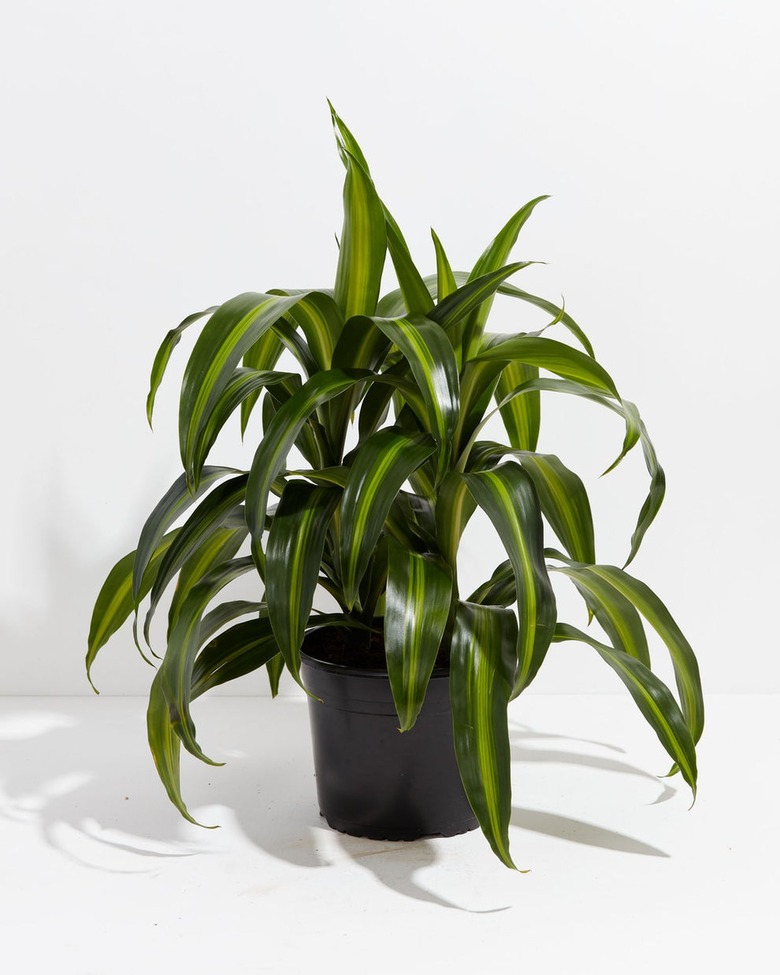Hawaiian Sunshine Plant Care
We may receive a commission on purchases made from links.
Hawaiian Sunshine (Dracaena 'Hawaiian Sunshine') is a green dracaena (Dracaena deremensis) cultivar that was developed from the Lisa (Dracaena 'Lisa') cultivar. The plant is characterized by dark green, downward-facing leaves that are marked with clean, bold chartreuse variegation. It's notable for its strong, consistent color and durability as a house plant. Like other Dracaena plants, Hawaiian Sunshine is fairly low maintenance and adaptable.
Ideal Growing Location
Ideal Growing Location
Hawaiian Sunshine is grown easily as a houseplant, accepting a variety of lighting conditions. Bright, indirect light is ideal, though Hawaiian Sunshine will tolerate dimmer light, including low, indirect light conditions. Dracaenas prefer daytime house temperatures between 60 and 70 degrees Fahrenheit and nighttime temperatures that are about 10 degrees cooler. Avoid areas with cold drafts.
These tropical plants can grow outdoors only in frost-free conditions. Any climate zones lower than U.S. Department of Agriculture plant hardiness zones 10B and 11 probably will be too cold for Hawaiian Sunshine. The best outdoor location is in indirect sunlight to avoid leaf burn. If you have a colder night when the temperature drops below 60 degrees, cover the plant or bring a potted Hawaiian Sunshine indoors.
Hawaiian Sunshine Environmental Preferences
Hawaiian Sunshine Environmental Preferences
Hawaiian Sunshine is tolerant of slightly alkaline to acidic soil and will grow well in a moist general purpose, well-draining houseplant potting mix indoors. The houseplant can benefit from a dose of liquid foliage plant fertilizer or time-release granular pellets, applied once a month in the spring and summer as per the label recommendations.
The plant enjoys humid conditions, although it can tolerate lower humidity levels. In the winter, when indoor air is drier, mist the leaves occasionally to add humidity. A humidifier near the plant can also help create an ideal humidity level for the plant.
Outdoor plants will tolerate most soils so long as they aren't salty. If planting multiple dracaenas in the ground, provide at least 24 inches of space between plants.
Pests Affecting Hawaiian Sunshine
Pests Affecting Hawaiian Sunshine
Dracaenas are susceptible to pests, such as mites, thrips, and mealybugs, though the long-term health rarely is affected by pests. Mites usually are most active in dry conditions, so keep Hawaiian Sunshine well irrigated, especially during the hot summer months. Pests often can be dislodged with a direct stream of water. Heavily infested leaves may be clipped off and destroyed. Thrips usually don't warrant insecticide.
Diseases of Hawaiian Sunshine
Diseases of Hawaiian Sunshine
Dracaenas are sensitive to fluoride and may develop scorched or brittle leaves if overexposed. Avoid potting mixtures that contain high amounts of perlite and fertilizers that contain superphosphate. If your tap water has high fluoride levels, use rainwater or demineralized water. If yellowish or tan leaf spots occur at the base of leaves, take extra care not to splash the foliage with water.
Dracaenas rarely develop disease, though watering to the point of flooding can cause root rot in the plant. Water the plant well at the base of the plant without allowing standing water, and let the soil dry before watering again. The plant can use more water when the top 2 inches of soil are dry.
References
- Greenhouse Grower: Fabulous Foliage
- Foremostco Foliage: Deremensis 'Hawaiian Sunshine'
- Clemson Cooperative Extension: Dracaena
- University of Florida Extension: Dracaena Deremensis Dracaena
- Penn State Extension: Dracaena Diseases
- University of California Integrated Pest Management Program: Dracaena, Corn plant, Dragon tree, Ti tree—Cordyline, Dracaena spp.*
